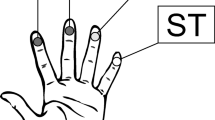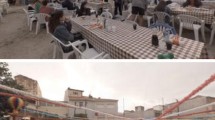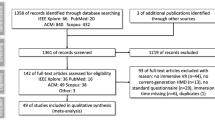Abstract
VR sickness (Cybersickness) presents an important challenge in virtual reality environments. We present the results of a study on the effects of VR technology and VR video content type on VR sickness and on autonomous nervous system of the user. The participants watched two omnidirectional (360°) videos of different content types (neutral and action) on five distinct video display types (2D TV screen, three generations of Oculus Rift VR HMDs and on the mobile Samsung GearVR HMD). The Simulator Sickness Questionnaire (SSQ) in combination with the measurement of the physiological parameters (skin conductance and skin temperature, respiratory frequency and heart rate) were used to monitor the participants’ physiology. The results show that video content significantly affects the SSQ grading and the skin conductance level. VR sickness effects were significantly reported less often with TV display type than with other VR HMDs.






Similar content being viewed by others
References
Earnshaw RA (1993) Virtual reality systems. Academic press
Castelvecchi D (2016) Low-cost headsets boost virtual reality's lab appeal. Nature 533:153–154
Fajfar I et al (2009) A top down approach to teaching embedded systems programming. Informacije midem-journal of microelectronics electronic components and materials 39(1):53–60
Chen M, Hao Y (2018) Task offloading for mobile edge computing in software defined ultra-dense network. IEEE J Sel Areas in Comm 36:587–597
Li P, Wang D, Wang L, Lu H (2018) Deep visual tracking: review and experimental comparison. Pattern Recogn 76:323–338
Gartner's (2016) Hype Cycle for Emerging Technologies. 2016. Retrieved August 22th, 2018 from http://www.gartner.com/newsroom/id/3412017
Oculus Rift CV1 (2018) Retrieved August 22th, 2018 from https://www.oculus.com/
HTC VIVE (2018) Retrieved August 22th , 2018 from https://www.vive.com/eu/
OSVR (2018) Retrieved August 22th , 2018 from http://www.osvr.org
Oculus Go (2018) Retrieved August 22th , 2018 from https://www.oculus.com/go/
Google DaydreamVR (2018) Retrieved August 22th, 2018 from https://vr.google.com/
Samsung GearVR (2018) Retrieved August 22th, 2018 from http://www.samsung.com/global/galaxy/gear-vr/
Sony PSVR (2018) Retrieved August 22th, 2018 from https://www.playstation.com/enus/explore/playstation-vr/
Jerald J (2015) The VR book: human-centered design for virtual reality. Morgan & Claypool
Lawson BD (2014) Motion sickness symptomatology and origins. Handbook Virt Environ. https://doi.org/10.1201/b17360-29
LaViola JJ Jr (2000) A discussion of cybersickness in virtual environments. ACM SIGCHI Bull 32:47–56
Pausch R, Crea T, Conway M (1992) A literature survey for virtual environments: military flight simulator visual systems and simulator sickness. Presence: Teleoperators Virt Environ 1:344–363
Kennedy RS, Lane NE, Berbaum KS, Lilienthal MG (1993) Simulator sickness questionnaire: an enhanced method for quantifying simulator sickness. Int J Aviat Psychol 3:203–220. https://doi.org/10.1207/s15327108ijap0303_3
Chessa M, Maiello G, Borsari A, Bex PJ (2016) The perceptual quality of the oculus rift for immersive virtual reality. Human–Computer Interaction, Published online:1–32. doi:https://doi.org/10.1080/07370024.2016.1243478
Rebenitsch L, Owen C (2016) Review on cybersickness in applications and visual displays. Virtual Reality 20:101–125
Steinicke F, Bruder G (2014) A self-experimentation report about long-term use of fully-immersive technology. Proc 2nd ACM Symp Spatial User Interact. https://doi.org/10.1145/2659766.2659767
Higuera-Trujillo JL, López-Tarruella Maldonado J, Llinares Millán C (2017) Psychological and physiological human responses to simulated and real environments: a comparison between photographs, 360 panoramas, and virtual reality. Appl Ergon 65:398–409
Singla A et al (2017) Measuring and comparing QoE and simulator sickness of omnidirectional videos in different head mounted displays. Ninth Int Conf Quality Multimed Experience. https://doi.org/10.1109/QoMEX.2017.7965658
Davis S, Nesbitt K, Nalivaiko E (2015) Comparing the onset of cybersickness using the oculus rift and two virtual rollercoasters. Proceedings of the 11th Australasian conference on interactive entertainment 27
Tong X et al (2016) Usability comparisons of head-mounted vs. stereoscopic desktop displays in a virtual reality environment with pain patients. Stud Health Technol Inform 220:424–431
Webb CM et al (2009) Simulator sickness in a helicopter flight training school. Aviat Space Environ Med 80:541–545
Park WD et al (2017) A study on cyber sickness reduction by oculo-motor exercise performed immediately prior to viewing virtual reality (VR) content on head mounted display (HMD). Vibroengineering PROCEDIA 14:260–264
Lin JJW et al (2002) Effects of field of view on presence, enjoyment, memory, and simulator sickness in a virtual environment. Proceedings IEEE Virtual Reality
Carvalho P et al (2017) VR Rio 360: the challenges of motion sickness in VR environments. International Conference on Virtual, Augmented and Mixed Reality
Stoffregen TA et al (2000) Postural instability and motion sickness in a fixed-base flight simulator. Hum Factors 42:458–469
Nishiike S et al (2013) The effect of visual-vestibulosomatosensory conflict induced by virtual reality on postural stability in humans. J Med Investig 60:236–239
Graeber DA, Stanney KM (2002) Gender differences in visually induced motion sickness. Proc Human Factors Ergonomics Soc Ann Meeting. https://doi.org/10.1177/154193120204602602
Gržinič Frelih N, Podlesek A, Babič J et al (2016) Evaluation of psychological effects on human postural stability. Measurement 98(February 2017):186–191. https://doi.org/10.1016/j.measurement.2016.11.039
Acknowledgements
We would like to thank all the participants for their time and effort. The authors acknowledge the financial support from the Slovenian Research Agency (research core funding No. P2-0246 and No. P2-0225).
Author information
Authors and Affiliations
Corresponding author
Ethics declarations
Conflict of Interest
The authors declare no conflicts of interest.
Additional information
Publisher’s note
Springer Nature remains neutral with regard to jurisdictional claims in published maps and institutional affiliations.
Rights and permissions
About this article
Cite this article
Guna, J., Geršak, G., Humar, I. et al. Virtual Reality Sickness and Challenges Behind Different Technology and Content Settings. Mobile Netw Appl 25, 1436–1445 (2020). https://doi.org/10.1007/s11036-019-01373-w
Published:
Issue Date:
DOI: https://doi.org/10.1007/s11036-019-01373-w




